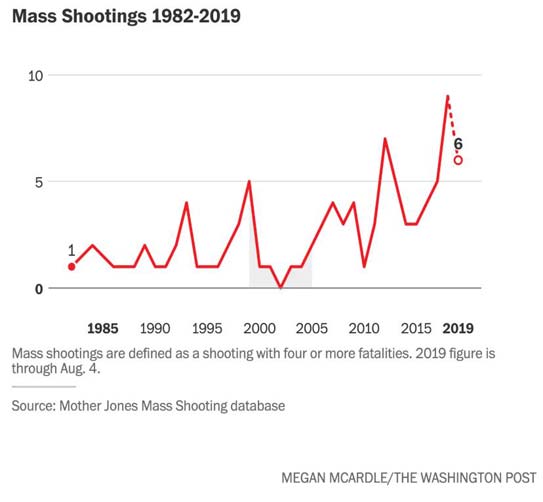
But having said conservatives need to find an answer, I'm obliged to suggest how they might do that. First, though, we need to define the problem. Why are so many mass shootings happening now? Why not decades ago, when the United States had plenty of guns, alienated youth, dysfunctional families, economically distressed communities, sexism and almost every other factor commonly blamed for these tragedies?
When trying to identify the causes of a social phenomenon, we don't want to know about background conditions, like "anomie" or "racism." We want to know what changed. Studying the Mother Jones database of mass shootings suggests one possible -- I'd argue probable -- answer.
 |
There are some problems with the Mother Jones data -- federal guidelines changed in 2013, redefining a "mass shooting" from at least four fatalities to three, so I've taken recent shootings with three fatalities out of the chart. Nonetheless, it provides a reasonably good look at the kind of random massacres under discussion, and what it shows is telling.
Mass public shootings used to be rare, freak events. But they spiked in the late 1990s, following the highly publicized 1998 Westside Middle School killings in Jonesboro, Ark. Then in 2000, mass shootings abruptly fell and stayed low for years. What changed?
Well, what do you remember from 2000-2004? The bursting of the dot-com bubble. Then a hotly contested election, which was almost immediately followed by the 9/11 terrorist attacks and then the Iraq War. These events took media attention away from other events, such as mass shootings. And just like that, the mass slaughter ground to a halt.
Mass shootings appear to be a social contagion, a behavioral epidemic.
We know that at least some mass shooters have been inspired by earlier killers. They seem to "catch" the diseased idea of committing a massacre by watching the wall-to-wall coverage of earlier massacres. The vectors are cable news and the internet.
That presents a challenge. There are two obvious policies that might stop mass killings: Either ban private gun ownership or ban extensive coverage of mass shootings. Both would violate the Constitution. But unlike the half-measures usually proposed after these killing sprees, both would probably radically reduce, if not entirely eliminate, them.
More and better mental-health treatment isn't the answer, because not all mass shooters have shown signs of needing it before they strike and many who need help wouldn't seek it. Nor would family or friends necessarily recognize the problem, or report it if they did. As for violent video games and entertainment, the available evidence suggests they play no role in real-world violence.
Looking leftward, background checks wouldn't work because many mass shooters buy guns legally, and those who can't display extraordinary dedication to acquiring weapons -- borrowing what they can't buy, stealing what they can't borrow.
Assault weapons bans wouldn't work because the deadliest thing about a gun is the fact that it fires a projectile at high velocity, not its largely cosmetic features such as pistol grips, folding stocks or barrel shrouds. Even a high-capacity magazine ban proved largely useless when the United States introduced one in 1994, which is one reason the law was allowed to lapse after 10 years.
Which seems to leave us with the same bad choice: Which part of the Bill of Rights do we want to amend, read out of the Constitution or simply violate outright? The First Amendment, or the Second?
Neither, I hope. In my next column, I'm going to try to point to a better way.
Every weekday JewishWorldReview.com publishes what many in the media and Washington consider "must-reading". Sign up for the daily JWR update. It's free. Just click here.
(COMMENT, BELOW)
Megan McArdle is a Washington Post columnist who writes on economics, business and public policy. She is the author of "The Up Side of Down." McArdle previously wrote for Newsweek-the Daily Beast, Bloomberg View,the Atlantic and the Economist.


 Contact The Editor
Contact The Editor
 Articles By This Author
Articles By This Author